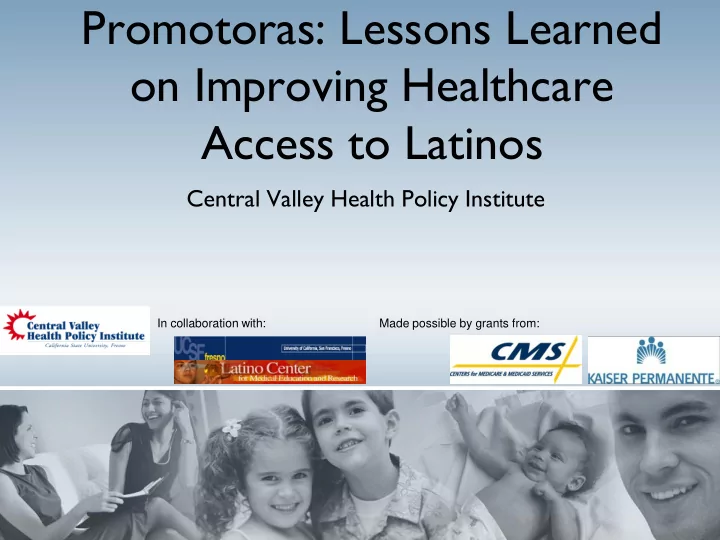

Promotoras: Lessons Learned on Improving Healthcare Access to Latinos Central Valley Health Policy Institute In collaboration with: Made possible by grants from:
Background • In 2006, the UCSF-Fresno Latino Center for Medical Education and Research (LaCMER) received a CMS HBCU/HSI Health Services Research Grant • In 2008, CVHPI received a Kaiser Permanente Community Benefits Program • Both grants allowed CVHPI to explore the “Promotora Model”
Background • Why Mexicans Immigrants? • The Promotora Model • Commonly referred to as Community Health Workers • People from and working for their own community
Aims • Examine the effectiveness of using trained Promotoras de salud to deliver an educational intervention to low- income Latinos in California’s Central Valley • Increase healthcare access to Central Valley immigrant elders and adults • Health Insurance • Medical Home • Preventive Service/Physical • Self-efficacy
Objectives I. Develop Pre- and Post-test instruments II. CBO Partnerships III. Recruit Promotoras IV. Promotora Training V. Resource Manual VI. Pilot-test Surveys VII. Implement and Evaluate Intervention
CMS and KP Funding • CMS allowed us to do a large study of adults and elder immigrants • 2007-2008 • KP allowed us to examine how well the program could be used for families of mixed legal status (at least one undocumented) • 2008-2009
Promotora Training • Modules • Four modules: 1) Background 2) Promotora Role 3) Motivational Interviewing 4)Importance of Access 5)Programs Available For more information about the modules, please visit CVHPI.org
Resource Manual • Unique, targeted, and specific • Contact Information • Spanish Speaking Contacts • Eligibility Rules • Varied Resources • Health Insurance to Transportation • Accessible • Ready to use tool for all, easier than a phone book!
Survey Instruments • Conducting motivational interviewing • Using survey as needs assessment tool • Filling out tracking sheets • Number and nature of contacts between client and promotora • Post-Test (3-months) • Did the Promotora provide the service? • Did the person follow up? • Why or why not? • Is the person more self-efficacious about seeking services?
Impact Indicators • Health Insurance • Does the participant have an insurance provider? • Medical Home • Does the participant have a medical home or primary care provider? • Physical/Preventive Service • Has the participant received a form of medical preventive care? • Self-Efficacy • How comfortable does the participant feel in making his or her own healthcare decisions?
Results Health Insurance • 45% of our respondents were uninsured at Citizens and baseline Residents • At follow-up, 80% were insured through Medicare, Medi-Cal, or a private insurance • Large majority (90% in our sample) uninsured, others rely on Medical-Emergency or buy meds at local pharmacy • Very few can afford private insurance(2%) Undocumented • At follow-up, 20% had health insurance • Others who could not be enrolled were referred to sliding-scale fee clinics
Results • All indicators showed dramatic improvements from baseline to follow-up • Both Legal Immigrants and Undocumented Immigrants
Results CMS TABLE 8. Paired- Sample T-test. Health care access indicators at Baseline and Follow-up Indicator Mean N SD t P Insured at Baseline 0.55 0.50 284 8.485 0.000 Insured at Follow-up 0.80 0.40 Source of Care at Baseline 0.62 0.49 272 9.221 0.000 Source of Care at Follow-up 0.92 0.27 Physical Received at Baseline 0.36 0.48 283 6.863 0.000 Physical Received at Follow-up 0.64 0.48 Self-efficacy at Baseline 2.19 1.15 289 12.147 0.000 Self-efficacy at Follow-up 3.24 0.87 0= No Service 1= Service p< .000
Results Kaiser TABLE 8. Paired- Sample T-test. Health care access indicators at Baseline and Follow-up Indicator Mean N SD t P Insured at Baseline 0.113 0.32 62 2.423283 0.018 Insured at Follow-up 0.226 0.42 Source of Care at Baseline 0.138 0.35 65 6.126514 0.000 Source of Care at Follow-up 0.585 0.50 Physical Received at Baseline 2.636 1.51 66 6.863 0.000 Physical Received at Follow-up 0.955 0.54 Self-efficacy at Baseline 0.300 0.47 20 4.48527 0.000 Self-efficacy at Follow-up 0.900 0.31 0= No Service 1= Service p< .05
Children • Undocumented Children living in mixed status families • Twenty-one undocumented children needed a referral for health insurance • 19 of those subsequently enrolled in the Kaiser Permanente Child Health Plan.
System Barriers • Fear of being reported, navigating a complex health system, and language barriers exist when seeking care Patient Quote “…for my people who do not know where or with whom to go with, or those of us who do not understand-we are scared of immigration agents.” • Waiting lists and stringent requirements block access Promotora Quote “It was lack of information…A lot of them complain….for the people it is very difficult to gather the required information.”
The Promotora Effect • Participants and Promotoras alike felt affected • Success- Promotoras felt motivated to help people very much like them get access to services “…not so much being Latina, but being from the same community and have had the same problems as me. They know I’m from the community, they know me and trust me.” • Challenge- Felt invested in some cases, worked beyond the scope of the project “100 hours is not enough, we did more than that because of the family needs, not because of the job.”
Lessons Learned • Promotoras can improve access to care and health care use for Latino immigrants • Because of systematic barriers to self-efficacy and appropriate use, promotoras are a needed component of the health system in our region • Sustainable funding for promotora training, placement and supervision are needed • Promotoras can be the link to the community for improving health access, addressing health emergencies, and increasing opportunities for Latino immigrants
Acknowledgements • Our Funding Sources • UCSF LaCMER • Centers for Medicare and Medicaid • Kaiser Permanente Community Benefits Grant Program • Alicia Gonzalez, Project Coordinator • Mariana Ramirez, Data Analyst • Suzanne Kotkin-Jaszi, DrPH • Helda Pinzon-Perez, PhD • Nancy Pacheco, Program Analyst • Promotoras • CVHPI Staff • Collaborating CBOs
Recommend
More recommend